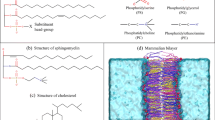Abstract
The hydrophobicity profile across a membrane is an important parameter of biological membranes as it defines the barrier for permeation of polar molecules into the cell interior and of the stability of transmembrane proteins. In this work, the hydrophobicity profile was measured by conventional continuos-wave electron paramagnetic resonance (CW-EPR) and by electron spin echo envelope modulation (ESEEM) in two liposome suspensions with different ionic strengths in order to compare the sensitivity of both methods for the determination of the water penetration depth into the liposome membrane. Multilamellar liposomes from egg-phosphatidylcholine, cholesterol and dicetyl phosphate were prepared in deuterium oxide, buffered with phosphate buffer with or without NaCl at the phosphate concentrations 0.1 or 0.01 M. Liposomes were spin labeled with stearic acids spin probes with the nitroxide group at different positions on the acyl chain. The deuterium penetration depth was measured by the ESEEM technique and the signal was analyzed in the frequency domain (Fourier transform [FT]-ESEEM). The ratio of the intensities of FT-ESEEM lines at deuterium and hydrogen Larmor frequencies was used as a measures of the water penetration depth. It was also indirectly determined from the hyperfine splitting constants in frozen and in fluid state, measured by CW-EPR, as they depend on the polarity of the nitroxide group environment. The comparison of the two techniques demonstrated that FT-ESEEM is more sensitive to the changes on the surface of the membrane and thus more appropriate for the determination of the hydrophobic barrier than the conventional CW-EPR method.
Similar content being viewed by others
References
Griffith O.H., Dehlinger P.J., Van S.P.: J. Membr. Biol.15, 159–192 (1974)
Subczynski W.K., Wisniewska A., Yin J.J., Hyde J.S., Kusumi A.: Biochemistry33, 7670–7681 (1994)
Hiff T., Kevan L.: J. Phys. Chem.93, 1572–1575 (1989)
Bartucci R., Guzzi R., Marsh D., Sportelli L.: Biophys. J.84, 1025–1030 (2003)
Noethig-Laslo V., Cevc P., Arcon D., Šentjurc M.: Orig. Life Evol. Biosph.34, 237–242 (2003)
Marsh D.: Proc. Natl. Acad. Sci. USA98, 7777–7782 (2001)
Kusumi A., Pasenkievicz-Gierula M.: Biochemistry27, 4407–4415 (1988)
New R.R.C.: Liposomes: a Practical Approach, p. 36, Oxford: Oxford University Press 1990.
Barbon A., Brustolon M., Maniero A.L., Romanelli M., Brunel L.C.: Phys. Chem. Chem. Phys.1, 4015–4023 (1999)
Johnson M.E.: Biochemistry20, 3319–3328 (1981)
Author information
Authors and Affiliations
Rights and permissions
About this article
Cite this article
Noethig-Laslo, V., Cevc, P., Arčon, D. et al. Comparison of CW-EPR and ESEEM technique for determination of water permeability profile in liposome membranes. Appl. Magn. Reson. 27, 303–309 (2004). https://doi.org/10.1007/BF03166324
Received:
Revised:
Issue Date:
DOI: https://doi.org/10.1007/BF03166324




